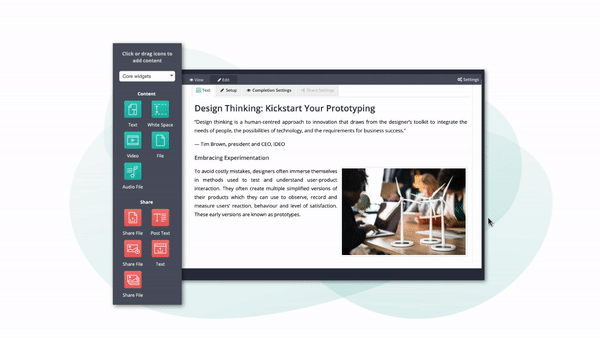What is your talent? What skills do people often compliment you for? Which topics do your friends or family often consult you on?
Yes, each of us has a talent, a strength, a skill — something that we know we are great at. It can be communicating superbly with people, baking sinfully delicious pastries, gardening, astrophysics, an elegant way with languages, a sharp mind for numbers, deep understanding of virtual reality, the sciences or simply a topic which you have deep knowledge in. If you possess a skill or expertise that you’d love to share with others, why not teach it online?
Now’s a great time to create an online course and jump aboard the online learning train. Why?
The Asia Pacific Region is one of the fastest developing regions in the world, and not surprisingly, comprises 32% of the e-learning market’s growth. In 2020, the COVID-19 pandemic roiled the world. Now, one year later, we find that every industry and area of life has been turned on its head. In many ways, this pandemic hastened the adoption of technology, especially in online education. Many people realised that in order to stay relevant in the new normal, they need to upskill and reskill quickly.
Your online course could be the one for them.
In this blogpost, I will share my own journey into the world of building online courses, how you can get started, and some tips and tricks that I’ve learned from seasoned Learning Designers who build online courses as a profession.
In the first part of my career, I was a corporate accountant.
My interest in education emerged when I travelled to Vietnam for a 1-month intensive teaching course: in between eating Vietnamese food and drinking its famous coffee every day, I learned teaching techniques and how to write lesson plans.

Photo by Arnie Chou from Pexels
In the ensuing years, I gradually made the career transition from corporate accounting into teaching at an international school. As with the rhythms of life, this is where I discovered Learning Design, which led me to build online courses professionally. My corporate background wasn’t lost in all of this; in fact, it regularly comes in handy as the experience gave me a wide exposure to various business areas.
So, with some training and effort, whether you are an educator, a subject matter expert, or someone with a unique passion — you can create online courses, too (and earn an income from it!).
In 2016, the World Economic Forum published The Future of Jobs Report. It was predicted that in the Fourth Industrial Revolution, most occupations will undergo a fundamental shift. This is already happening with developments in genetics, smart technology and even pandemic preparedness around the world.
How does this impact education, and what opportunities are available to help us become successful online course creators?
Educational institutions will need to relook at their curriculums to ensure that it is aligned to future in-demand knowledge and skill sets. Career opportunities are available in this space: in the US, the annual US News university ranking assessed over 1600 online programs for its 2021 ranking report, its largest number yet. With a growing need for online program management, institutions will likely be on the lookout for educators who are skilled at delivering online learning experiences.
Companies, too, need to adapt their business models and strategies to survive and hopefully, thrive. To support the companies’ future direction, their workforce needs to be reskilled and retrained. For example, Mastercard encourages its staff to develop new skills using an online learning platform called Degreed. Degreed offers personalised learning experiences, and its adoption rate has increased from 60% when it was first launched in 2016 to 96% in 2020.
Prior to the COVID-19 pandemic, educational technology was already riding on a wave of high growth. According to a report by Global Market Insights, Inc published in May 2020, in 2019, the global eLearning market was worth more than USD 200 billion. By 2026, the world online education market is projected to touch USD375 billion, with an average growth of 8% per annum. As an independent educator, you can tap into this market by sharing your unique expertise in a paid online course.
Asia accounts for about 50% of all internet users in the world. Many of these users rely on their smartphones for internet access. Online course creators who offer engaging yet low-bandwidth educational content will find a large global audience in the mobile online learning market.
Technology has changed the way we teach and learn. Today, educators are finding creative ways to teach online — on social media, YouTube channels (such as TED Talks and Khan Academy), video conferencing tools, and more. On this cue, many online learning platforms are incorporating the latest educational research with user-friendly features that make it easier for you to create online learning experiences.
For instance, the OpenLearning platform is built upon Social Constructivism: a philosophy that relies on the power of online communities to foster deep, active learning. Building an online course like this is as easy as dragging and dropping widgets onto “pages” in the course. A new feature called Page Templates was released in October 2020, enabling you to choose from a selection of ready-made pages that have been populated with widgets according to proven learning design patterns.

Therein lies the potential for aspiring educators. Exciting! But, how do you get the ball rolling?
As an educator or subject matter expert, you possess domain knowledge in your field of expertise. You know where to find information and resources related to your subject matter — that’s one important ingredient in the bag! To build an online course, you need to add a few other ingredients: knowledge of learning theory or philosophy, learning design models, how to use educational technology tools and navigating an online learning platform. Although it may seem a bit daunting at first, nowadays, there are many user-friendly learning platforms such as OpenLearning.com that can help you in this mission.
Here are a few tips to get you started:
By taking on the role of a student, you get a front-row seat to see for yourself how online learning works. For example, how learning materials are delivered, the interaction between students and course facilitators online and the various ways assessments can be performed. The best part is, you can assess the effectiveness compared to face-to-face classes. Click here to join 10 of the great online courses on OpenLearning.
Courses on the topic of Learning Design will give you a great foundation to kickstart your journey in creating online courses. For example, OpenLearning.com offers the Learning Design Series of 3 courses, where you get to learn about Learning Design Basics, Facilitating for Success and how to Design a world-class course. These courses expose you to the Social Constructivist learning philosophy adopted by the platform and provide a sandbox environment for you to explore everything that goes into building your own course.
Explore the websites of various EdTech companies. What features are offered in each learning platform? Is it user-friendly? What support is offered to course creators? Does it have an active student community?
Then, shortlist and contact them to find out about their services and support. For example, OpenLearning offers localised services in the form of learning design consultation, and provides support via webinars, Course Creator Guides and a handbook to support first-time course creators.
The Course Creators’ Handbook provides step-by-step instructions, suggestions, and resources to guide first-time course creators through the following journey:

Educators are also supported by a Customer Success Team, whom they can email or chat with directly for assistance on technical issues while navigating the platform.
Asking these questions will help you to narrow down your search and choose a platform that works for your unique needs.
Rich resources on online learning and education can be easily accessed from the comfort of your home — without needing to register or make a commitment. You can start by exploring websites such as these:
https://elearningindustry.com/
https://educationaltechnology.net/
https://www.elearninglearning.com/
If creating online courses is something new for you, websites like these will give you a feel for what it’s like to be an online course creator. They can also save you some time by providing advice from experienced Learning Designers — we shall explore this next.
Here’s some great advice from experienced learning designers that can guide your journey:
And finally,
Earlier on, when I was developing my knowledge in Learning Design as a part-time student, the theoretical and basic foundational aspects such as learning theory, learning design models and educational technology tools took on a more prominent role. We also created portfolios to practise and showcase our work.
But now, being truly out in this field and working on real projects, I find it most helpful to seek advice from experienced Learning Designers that are worth their weight in gold. Whether it’s in the form of a blog post, a podcast, or even a quick chat — practical Learning Design advice provides a beacon to guide new Learning Designers and compels us to think deeper, to go the extra mile, and to create an interesting and valuable online learning experience for our learners.
As we can see from recent education trends, great potential lies in store for online education. If you’ve always wanted to share your knowledge, but aren’t sure how to kickstart it, 2021 is a great time to roll up your sleeves and embark on this exciting journey. Create your very own online course and share it with the world!
OpenLearning is an online learning platform with a focus on community, connectedness and engagement. Join our latest webinar to find out more:
Featured Image: Photo by Buro Millennial from Pexels
